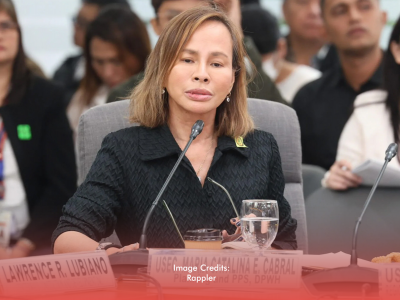The names Pacifico “Curlee” Discaya II and Cezarah “Sarah” Discaya have become household symbols of the so-called “ghost flood control projects.” Their family’s companies allegedly cornered more than P30 billion worth of contracts in just three years, while their garage filled with luxury cars. Senate hearings have paraded them as villains.
But here’s the uncomfortable truth: the Discayas are not the brains of the operation. They are simply the most visible beneficiaries of a much deeper rot. Ghost projects do not begin with contractors. They begin in Congress, move through DPWH, are anchored in districts, tolerated by LGUs, and finally executed—or not executed—by favored contractors.
This is not just a story of corruption. It’s a story of how public works have been weaponized as pork.
The Systemic Problem: Insertions by Design
The official budget process starts with the National Expenditure Program (NEP) drafted by the Department of Budget and Management, which includes projects vetted by line agencies like DPWH. But once the budget reaches Congress, a shadow process unfolds.
During the bicameral conference committee (bicam), lawmakers push “last-minute” items into the budget—the General Appropriations Act (GAA)—often without feasibility studies, engineering designs, or even DPWH’s knowledge. These are the so-called “insertions.”
This loophole is where ghost projects are born.
Between July 2022 and May 2025, around P545 billion was allocated for nearly 10,000 flood-control projects. Watchdogs found clear anomalies: cookie-cutter floodwall designs, identical costs (sometimes down to the last peso) across different provinces, and billions funneled to just a handful of firms.
These patterns don’t happen by accident. They are the hallmark of pork-barrel engineering, carried out on a national scale.
Who’s Behind the Projects?
The chain of accountability is clear—but rarely exposed in full:
- * Congress (Insertion) – Lawmakers embed projects in the budget during bicam, bypassing DPWH vetting. These items often appear suddenly and disproportionately in their own districts.
- * DPWH (Implementation) – Once projects appear in the GAA, DPWH has no choice but to implement them, even if they were never part of the agency’s technical plan. Weak oversight makes it easy for anomalies to pass.
- * Districts (Project Hosts) –Inserted projects are tied to lawmakers’ districts, where politicians later claim credit for “bringing in” funding, regardless of whether anything is built. In Bulacan, for example, District Engineer Henry Alcantara has been repeatedly cited in watchdog reports as the gatekeeper of flood-control funds flowing into his area—funds that often vanish on paper long before any real structure rises.
- * LGUs (Local Governments) – Local officials are supposed to verify and monitor implementation. Instead, many turn a blind eye, signing off paperwork while rivers and creeks remain unchanged.
- * Contractors (Execution) – Only at the tail end do contractors enter. Some, like the Discayas, reportedly used multiple affiliated companies to simulate competition in bidding. Others “rent” licenses from established firms. Many collect funds, deliver substandard work—or build nothing at all.
This is not a failure of one agency or one family. It’s an ecosystem of collusion, sustained because every player benefits—except the public.
Ongoing Probes and Audits: Missing the Bigger Fish
The scandal has sparked Senate and House investigations, but the spotlight remains narrow. Contractors are grilled in public hearings, while lawmakers—the architects of insertions—escape scrutiny.
The Commission on Audit (COA) has repeatedly flagged flood-control anomalies since 2017, from duplication to poor-quality construction. After the scandal erupted, COA announced a performance audit requiring geotagged inspections to confirm if projects truly exist.
New DPWH Secretary Vince Dizon has ordered a temporary freeze on local flood-control bidding while reforms are reviewed. But again, these moves largely address the execution stage—not the insertion stage, where the rot begins.
As Senator Panfilo Lacson, long a critic of budget insertions, once warned: “If not for the lawmakers’ insertions, there would be no ghost projects for contractors to exploit.” Yet Congress continues to shield itself from deeper investigation.
What Must Change: Breaking the Pork Pipeline
Ending ghost projects requires dismantling the insertion machinery that fuels them:
- * Transparency of Insertions – Every bicam change must be disclosed with the name of the lawmaker who requested it. No more anonymous budget tweaks.
- * Accountability by District – Districts repeatedly hosting ghost projects must be flagged publicly. Voters should know when their representative is complicit in fake spending.
- * Geotagging and Photo Evidence – All completed projects must be documented with GPS coordinates and time-stamped photos, accessible in an open database.
- * Blacklist with Real Teeth – Contractors caught delivering substandard or fake works should be banned nationwide. But accountability shouldn’t stop there: lawmakers proven to have abused insertions must also face sanctions.
The Real Flood
Flood-control funds are supposed to protect communities from disaster. Instead, they have become conduits for pork, draining billions into ghost projects that exist only on paper.
Every rainy season, ordinary Filipinos wade through knee-deep floods while “floodwalls” and “river protection works” remain nothing more than line items in the GAA.
The Discayas may be the public face of the scandal, but they are not its architects. The real engineers of this corruption sit in Congress, shielded by a broken budget process.
Until investigations pierce that wall of impunity, the cycle will repeat: floodwaters rising in our towns, and pork flooding our budgets.
Because the problem is not just missing projects. The problem is a system where pork is prioritized over people.








